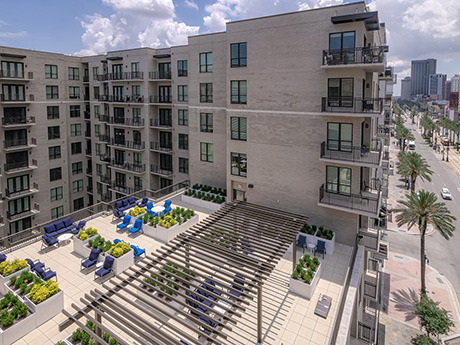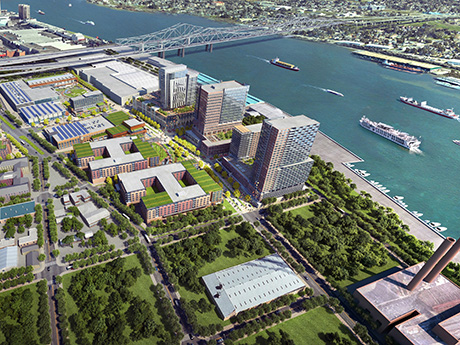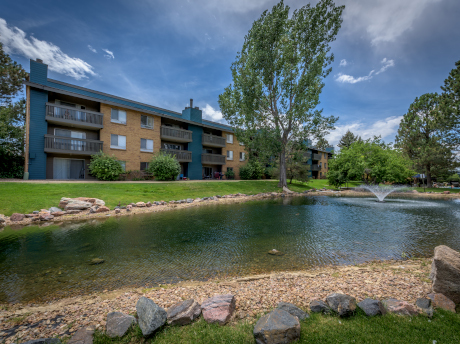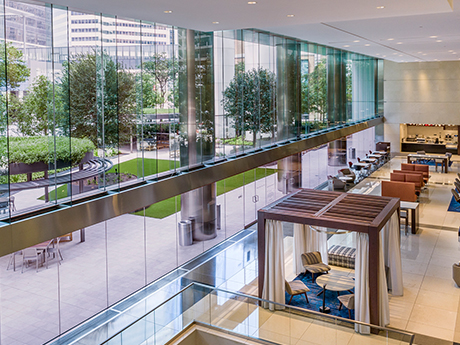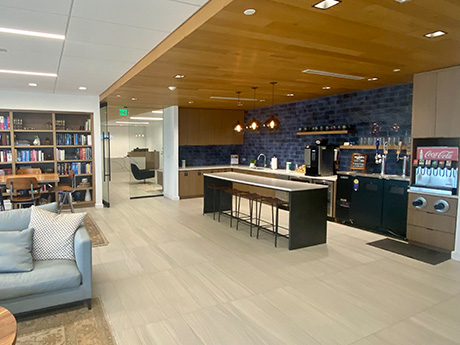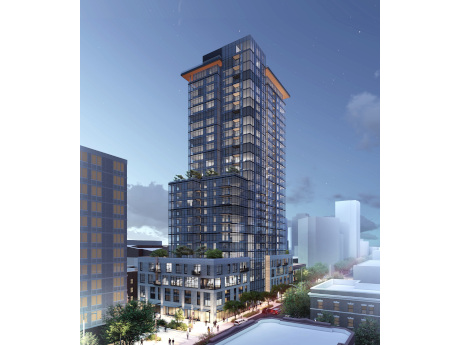By Taylor Williams Success in today’s office sector is all about creating incentives. Some companies, from small professional services outfits to tech giants like Salesforce and Airbnb, have completely capitulated to remote work and have aggressively slashed their office footprints. Others remain dogged in their commitments to nonresidential (and nonretail) workspaces. What works for one company may not work for its competitors, and there remains a fundamental need for at least some traditional office space across all major markets. Against this backdrop, what separates the winners from the losers is the ability to create a draw, to give people legitimately good reasons to get up earlier, spend more time getting ready, endure traffic, put costly mileage on their cars, then deal with whatever quirky goings-on define their office experience. Needless to say, this can be a tough sell, especially for employees with families and suburban commutes. Which is why owners, both of businesses and of the office buildings that house them, are getting creative. These corporate leaders and landlords are working in tandem to ensure that the spaces meet the precise needs of their workforces, from design and layout within the suite to access to onsite amenities and surrounding retail, …
Market Reports
Increased interest rates and challenging insurance costs would normally stifle a multifamily market. However, an inventory constrained by a lack of land, supply chain issues, labor shortages and the increased cost of homeownership have contributed to a further stabilization of the metro New Orleans multifamily market. The overall vacancy factor for our seven primary submarkets that make up metro New Orleans are in the 5 to 6 percent range. We anticipate occupancy rates to steadily increase going forward as new construction has stalled and rising interest rates have delayed many tenants from transitioning to homeownership. Overall rental rates in the metro average in the $1,250 to $1,350 per month range. The rents represent a 3.5 percent increase over the past 12 months. It should be noted that some submarkets have seen considerably higher increases. The highest rental rates reported in the metro for garden-style communities are in Eastern St. Tammany Parish, where the newest inventory exists. The highest rents in New Orleans are downtown in the CBD/Warehouse District. These communities comprise mid-rise and high-rise developments and command rents exceeding $2.50 per square foot. The downtown market experienced some softness during the COVID-19 pandemic but made a robust recovery once restrictions …
By Steve Roppel, Senior Vice President, Allied Commercial Real Estate Encompassing 62 square miles, San Bernardino is the governmental seat of San Bernardino County, the largest county in the world at more than 21,000 square miles. About 86,000 people alone work within the city, per the 2020 Census. The largest industries are retail (12,280 people), transportation and warehousing (11,164 people) and health (9,603 people). Of the six largest office buildings, only one is occupied by traditional multiple commercial tenants. The others are occupied by the county, city, courts, non-profits and the University of Loma Linda. The only large office building presently proposed is a county office building of 307,000 square feet. San Bernardino was historically a vibrant metropolitan whose image has become tarnished over the years. It is famous for its affiliation with Route 66, which runs through the city and allowed many people to emigrate to the Golden State. The first original McDonald’s restaurant – now a museum – was opened in San Bernardino in 1940. To restore the former luster and recognize the potential for San Bernardino, local governments have pulled together on several fronts. Multiple recent infrastructure improvements and redevelopments were completed and planned for San Bernardino, …
By Jason Baker of Baker Katz It’s amazing how quickly things can change. Just a few short months ago, the commercial real estate outlook was generally positive. Both in Texas and nationally, retail sales were proving to be fairly resilient to the rising inflation and economic turbulence that have characterized most of 2022. Despite low consumer confidence, strong fundamentals and a retail sector riding the high of a post-pandemic boom provided plenty of reasons for optimism. That has all changed in the last 60 to 90 days. Prevailing positivity has recently given way to concern, and sentiment from within the industry has clearly shifted. High interest rates have made it virtually impossible to develop any type of commercial project, and persistent supply chain constraints and ongoing hikes in costs of construction materials have further exacerbated this challenge. With interest rate increases come higher cap rates, which complicates sellers’ efforts to move their assets while values are this fluid. To put the impact of rising rates into perspective, interest payments on commercial real estate have in some cases increased five-fold in just the last few months. The impact of this activity on retail real estate during the all-important holiday shopping season …
New Orleans has seen significant, pent-up retail growth over the past 12 months as we emerge from the COVID-19 pandemic. More recently, however, external forces have provided some headwinds and caused tenants and investors to go back to their corners to reassess. Inflation, rising interest rates, insurance premium increases and elevated construction costs have all contributed to uncertainty in the Greater New Orleans retail landscape. Within the French Quarter and CBD, growing concerns from crime have forced some CEOs to look outside of the city core for their office headquarters. This issue, coupled with the current “work-from-home” environment, causes downtown retailers to rely even more on tourism and convention business. Thankfully, the hospitality sector has had success and is now exceeding pre-pandemic levels. Due to an active 2021 hurricane season that saw Hurricane Ida devastate South Louisiana, insurance rates have skyrocketed as carriers continue to leave the state. As a result, landlords have struggled with how to handle these unforeseen spikes in expenses. Should they pass those on to the tenant or eat them to remain competitive, or a combination of the two? 2022 has been a surprisingly quiet storm season, so with any luck these rates should begin to …
Like many communities across the West, affordable housing is a top issue in Denver. Monthly rent in Denver is now around $2,005, according to Zillow’s June 2022 data. This is up 20.4 percent since June 2019. The city is trying to do something about the lack of affordability. It approved the Expanding Housing Affordability Policy (EHA) this June, which overhauled Denver’s affordable housing requirements for new development. EHA was allowed after the 2021 passage of a Colorado statute, HB21-1117, which overturned a Colorado Supreme Court case commonly known as the Telluride decision. HB21-1117 expanded the ability of local Colorado governments to require inclusion of income-restricted units within new rental housing — something that had previously been prohibited in Colorado. While Denver has led within the state with EHA, other municipalities in Colorado, such as Littleton and Aspen, are beginning to consider new affordable housing policies in response to HB21-1117. In Denver, EHA primarily affects multifamily projects of 10 or more units. Those projects must proceed under EHA unless they submitted a concept site plan by June 30, 2022, and achieve final site development plan approval by Aug. 30, 2023. Non-residential projects and residential projects of nine or fewer units may …
By Chip Colvill, executive vice president, Cushman & Wakefield Like many U.S. cities in the post-pandemic world, Houston’s office sector faces a long road to recovery. Historically, office demand follows office job creation — and job growth has been a bright spot of the Houston economy in 2022. Unfortunately, the U.S. economy seems to be slowing, and the outlook remains highly uncertain. Odds of a recession have risen; inflation and wage pressures remain elevated, and higher interest rates are impacting various parts of the economy, including commercial real estate. Throughout the United States as well as in Houston, the correlation between job growth and office demand is tenuous, given that many businesses are still recalibrating workplace strategies to allow remote and hybrid work schedules. However, new jobs — even more flexible, hybrid jobs — will necessitate various types of workspaces, including demand for office and flexible office space. Newer office buildings across Houston have thrived despite the market’s elevated Class A vacancy rate of approximately 26 percent. Each new quarter of data continues to confirm the flight-to-quality trend and the existence of a bifurcated office sector between older and newer office product. Higher-quality and newer office space is dominating as …
In the post-pandemic environment where employers are trying to navigate new work schedules, office tenants are focusing more on the finish and design of office space than they are the rents. In New Orleans, we are seeing office tenants rethink the concept of office space altogether, and their employees are thinking differently about their individual offices as well. There has been a shift from the traditional office space of years past where one spends eight hours a day in a large private office with the door closed. The office has evolved into more of a social place. Companies want their employees to come back to the office and not to be fully remote. Many employees want to get out of their pajamas and come back to the office. But, getting them all to come back has proven to be the challenge. Companies are now enticing their employees with redesigned spaces that are more aesthetically pleasing and rich with amenities that allow for more social interactions and collaboration. Employees who work remotely a few days a week are coming to the office because they want that engagement with their colleagues. Tenants are now less interested in refurbishing private offices and spend …
By Brian O’Connor, Executive Director, Valuation & Advisory, Cushman & Wakefield The Seattle Metro apartment market has been surprisingly resilient. The market quickly bounced back from the COVID downturn at a robust clip and has continued moving at a healthy pace. During the first six months of 2022, metro Seattle absorbed more than 12,600 units. That already surpasses a typical full year of demand by several thousand units. From January 2022 through June, the market absorbed 3,779 newly constructed units — a respectable level. If you also factor in the decline in existing units, then the market absorbed another 8,886 units. That tells us that the supply of new units was too low…or demand was much stronger than we expected. The market had rebounded to a metro-wide vacancy rate of only 1.33 percent at mid-year 2022, an astoundingly low level. From year-end 2021 to June 2022, overall apartment vacancies declined from 3 percent to 1.33 percent. We do, however, expect vacancies to begin increasing slightly. These rates typically see an uptick as we head into winter. Rent growth also slows during this time. We expect to see the metro-wide vacancy rate start to rise just a bit by year-end 2022, to …
By David Hodge, NAI Greywolf The demand for commercial industrial real estate was exceedingly strong in the Milwaukee market leading up to the onset of COVID-19. The economy and labor markets were also strong and incentives for onshoring spurred on this growth. Post-pandemic commercial industrial product continues its upward trend. The catalyst for this, however, is international supply chain disruptions. The reaction to this unfortunate circumstance is the accumulation of higher inventories of raw material and finished goods. The resulting impact is high demand, especially for warehouses, in an extremely low vacancy rate environment. Demand beating inventory According to Catylist, in the second quarter of 2022, the Milwaukee market’s vacancy rates were 3.3 percent for all commercial industrial products. This is largely due to the continued lack of available inventory. High demand in part has spurred increases in rental rates to approximately $5.98 per square foot triple net. While this is good news for landlords who look to capitalize, it presents challenges for tenants who are expanding their operations. The other factor driving rental rates is the rapid increase in interest rates. The upcoming election may also affect the rates in the later part of the fourth quarter of …



